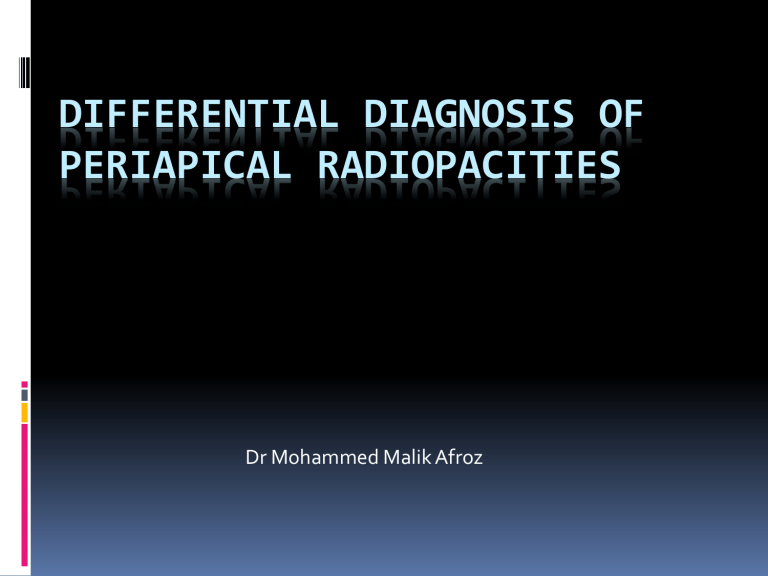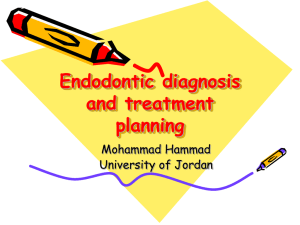differential diagnosis of periapical radiopacities

DIFFERENTIAL DIAGNOSIS OF
PERIAPICAL RADIOPACITIES
Dr Mohammed Malik Afroz
Format
Enumeration of Periapical Radiopacities
Radiographic Appearance
Differential Diagnosis
Conclusion
Specific Learning Objective
To know the different periapical radiopacities
Methods to differentiate between each radiopacity
Radiographic features of them
Enumeration of Periapical Radiopacities
Solitary Radiopacities –
Exostoses and tori
Osteoma
Retained root
Osteosclerosis
Socket sclerosis
Foreign objects in the jaws
Condensing osteitis
Garré's osteomyelitis
Hypercementosis
Multiple Radiopacities –
Odontoma – complex and compound
Periapical cemental dysplasia (calcified stage)
Cementoblastoma
(calcified stage)
Cementifying and ossifying fibromas (calcified stage)
Florid osseous dysplasia
(diffuse cementosis)
Solitary Radiopacities –
Exostosis and Tori
Exostoses are small, irregular overgrowths of bone developing on the surface of the alveolar bone.
They consist primarily of compact bone and produce an ill-defined radiopacity
Torus mandibularis — lingual
aspects of the mandible, in the premolar/molar region
• Torus palatinus — either
side of the midline towards the posterior part of the hard palate
Differential Diagnosis
Tori are present in the lingual or palatal aspect
Exostosis are seen as radiopacities which are outside the periosteal bone. Are less dense in nature
Enostosis – these are seen as frank radiopaque lesions and are very dense.
Can be diagnosed clinically.
Solitary Radiopacities –
Osteoma
Osteomas are benign tumors of oral cavity.
Seen in young adults
Asymptomatic, solitary lesions
Compact or Endosteal osteoma — consists of dense lamellae of bone and including the so-called ivory osteoma seen in the frontal sinus
Cancellous or Periosteal osteoma — consists of trabeculae of bone.
Differential diagnosis
Not assocaited with a dental infection
Causes tooth displacement
Very radiopaque in nature
Retained Roots
May be seen as accidental findings in old patients
Clinically the ridge may be totally healed or may have a flabby tissue
When radiograph is taken there may be a root piece.
Radiographically has pulp chamber and density of dentin which help in diagnosing the condition.
Osteosclerosis
Is seen as a radiopacity in the periapical region of the teeth.
It may involve one teeth or seen between any 2 teeth.
If it is due to trauma from occlusion – traumatic osteosclerosis
Idiopathic osteosclerosis – when no cause can be established.
Differential Diagnosis – seen as a periapical scleosis. Using localization method can help to identify, where in a periapical infection is always attached to the tooth while osteoclerosis is not.
Involved tooth is vital.
Socket Sclerosis
Seen in adults. M > F
Due to an old infected tooth which initiates growth in adjacent bone and causes the resorption of periodontal ligament space.
In this condition the root directly fuses with the bone.
Differential Diagnosis – socket sclerosis
Condensing osteitis osteosclerosis history reveals a highly infectious tooth.
The tooth may have lost its crown structure totally or partially.
Radiograph does not show any radiolucency surrounding the roots suggesting direct bony fusion.
Tooth root is seen as a hazy picture surrounded by the trabeculae of the teeth.
Foreign Object in the Jaw
Seen as a frank radiopacity not confirming to the human biology
Usually has a relevant shape.
Needs to have caution where direct relation to opacity cannot be established
Idiopathic osteosclerosis
Socket sclerosis
Residual sclerosis
Condensing Osteitis – Chronic
Focal Sclerosing Osteomyelitis
Young adults – M > F.
Common in first molars
The involved tooth is carious.
Patient gives a history of long standing periapical infection.
History of inadvertent (illogical) use of antibiotics
Seen as diffuse radiopacity surrounding the periapical radiolucency of the involved tooth.
Differential Diagnosis –
Condensing Osteitis
Idiopathic osteosclerosis
Antibioma
Tori
Exostosis
Can be best judged by localization technique where anatomical landmarks change while the infection is always connnected to the tooth.
Garre’s Osteomyelitis
There is focal gross thickening of periosteum with peripheral reactive bone formation resulting from mild irritation or infection
Seen in young adults; M >
F
There is mild pain, swelling and tooth ache.
History of long standing dental infection
Classical ‘ Onion Skin
Appearance’
Clinical bony hard swelling
Differential Diagnosis
Chronic periapical abscess
Periapical granuloma
Classic presence of
Onion Skin Appearance
Hypercementosis
Excess of cementum deposition at the apex of the tooth.
The radiodensity of the lesion is equal to the dentin
Surrounds all of the tooth and is followed by a radiolucent rim of periodontium
Involved tooth is vital.
Involves multiple teeth.
This is an accidental findings on routine radiographs.
Differential Diagnosis –
Idiopathic osteosclerosis
Condensing osteitis osteoma
Thank You
Any Questions ?




